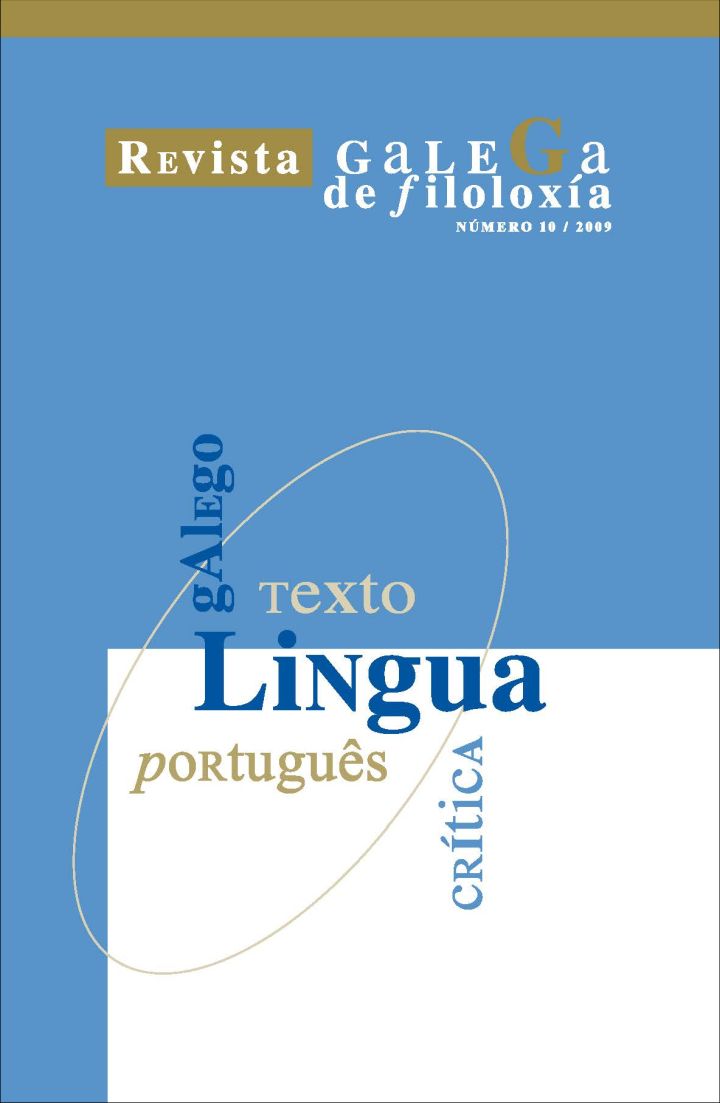Centrality and Prominence in Grammatical Relations
Main Article Content
Abstract
This paper starts with a brief overview of the core-periphery opposition through the successive levels of abstraction which can be identified in the process of utterance construction: from the actual, individual speech act up to the abstract, schematic level of syntax, going through the lexicon. From this point of departure, the study focuses on the syntactical level of grammatical relations, arranged according to a centrality hierarchy which evokes and somehow encodes the conceptual prominence of the entities making up the speaker’s mental image of his/her own message. Special attention is paid to the intermediate zone of this hierarchy, where non-Direct Object complements (IO, PO) are found. According to what is proposed here, these relations converge in such a region as a result of opposite dynamics (promotion and demotion strategies), which are described on the basis of data from Galician.
Keywords:
Downloads
Metrics
Article Details
References
Atkinson, R. C. / Shiffrin, R. M. (1968): “Human memory: A proposed system and its control processes”, en Spence, K. W. / Spence, T. (eds.), The Psychology of Learning and Motivation. Vol. 2 (New York: Academic Press).
Báez San José, V. (1988): Fundamentos críticos de la gramática de dependencias (Madrid: Síntesis).
Cano Aguilar, R. (1981): Estructuras sintácticas transitivas en el español actual (Madrid: Gredos).
Croft, W. / Cruse, D. A. (2004): Cognitive Linguistics (Cambridge: CUP).
Dik, S. C. (1997) [1989]: The Theory of Functional Grammar. Part 1: The Structure of the Clause (Berlin; New York: Mouton de Gruyter).
Du Bois, J. W. (1985): “Competing motivations”, en Haiman, J. (ed.), Iconicity in Syntax: 343-365 (Amsterdam: John Benjamins).
Ferrater Mora, J. (1976): Diccionario de Filosofía (Madrid: Alianza).
Foley, W. / van Valin, R. D. (1984): Functional Syntax and Universal Grammar (Cambridge: CUP).
Givón, T. (1998): “The functional approach to grammar”, en Tomasello, M. (ed.), The New Psychology of Language. Cognitive and Functional Approaches to Language Structure: 41-66 (Mahwah, N. J: Lawrence Erbaum Associates).
García-Miguel, J. M. (1995a): Las relaciones gramaticales entre predicado y participantes (Santiago de Compostela: Universidade de Santiago de Compostela).
García-Miguel, J. M. (1995b): Transitividad y complementación preposicional en español (Santiago de Compostela: Universidade de Santiago de Compostela).
García-Miguel, J. M. (1999): “La expresión de actantes centrales en español (romance) y bribri (chibcha): tipología, discurso y cognición”, en Vilela, M. / Silva F. (eds.), Actas do 1º Encontro de Lingüística Cognitiva: 101-121 (Porto: Faculdade de Letras da Universidade do Porto).
Langacker, R. W. (1991): Foundations of Cognitive Grammar. Vol. 2: Descriptive Application (Stanford: University Press).
Moreno Cabrera, J. C. (1991): Curso universitario de lingüística general. Tomo I: Teoría de la gramática y sintaxis general (Madrid: Síntesis).
Moure, T. (1996): La alternativa no discreta en lingüística. Una perspectiva histórica y metodológica (Santiago de Compostela: Universidade de Santiago de Compostela).
Rojo, G. (1985): “En torno a los complementos circunstanciales”, en Lecciones del I y II Curso de Lingüística Funcional: 181-191 (Oviedo: Universidad de Oviedo).
Rojo, G. (1990): “Sobre los complementos adverbiales”, en Jornadas de Filología / Profesor F. Marsá: 153-171 (Barcelona: Universitat de Barcelona).
TLP2 (1966) = Travaux Linguistiques de Prague, 2 [= Les problèmes du centre et de la périphérie du système de la langue] (Prague: Éditions de l’Académie Tchécoslovaque des Sciences).
Trujillo, R. (1988): Introducción a la semántica española (Madrid: Arco Libros).
Vachek, J. (1966): “On the integration of the peripheral elements into the system of language”, Travaux Linguistiques de Prague, 2: 23-37.
Vázquez Rozas, V. (1995): El complemento indirecto en español (Santiago de Compostela: Universidade de Santiago de Compostela).
Willems, D. (1981): Syntaxe, lexique et sémantique. Les constructions verbales (Gent: Rijksuniversiteit).



